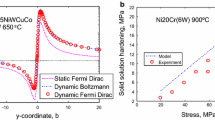Abstract
Creep crack growth in two of the commonly used creep-resistant ferritic steels was investigated. Both steels were tested in the as-processed condition and after many years of service in electric power plants. The test temerature was 540°C (in one case also 500°C and 565°C) and test durations ranged from a few days to a year. In 1/2Cr-1/2Mo-1/4V steel, crack growth occurred intergranularly by grain boundary cavitation, while 21/4Cr-1Mo steel also exhibited transgranular growth. The deformation behavior of CT specimens was analyzed in detail. It was found that for typically 20 percent of the lifetime, the instantaneous elastic-plastic strains and, more importantly, primary creep determine the deformation response. The evolution of the crack length parallels that of the load-line deflection: Initially, the crack grows relatively fast, decelerates until a steady growth rate is reached, and finally accelerates due to the increasing stress intensity at the longer crack. This behavior can be described reasonably accurately by models for creep crack growth taking into account the elastic-plastic transient and primary creep. It is demonstrated that the C t parameter correlates crack growth rates during the transients, whereas C * becomes the appropriate load parameter during steady-state creep. However, C * fails to describe crack growth in single-edge notched tension specimens with shallow cracks. This is tentatively ascribed to excessive crack-tip blunting and other geometry changes. Unloading and reloading frequently leads to accelerated crack growth.
Résumé
On a étudié la croissance de fissures de fluage dans deux des aciers ferritiques résistant au fluage les plus communément utilisés. Les deux matériaux ont été essayés à l'état de livraison et après plusiers années de service en centrale électrique. La température d'essais était de 540°C (avec, dans un cas, des valeurs de 500°C et 565°C) et la durée d'essais variait de quelques jours à une année. On a constaté que dans l'acier au 1/2 Cr-1/2Mo-1/4V, la fissure s'est propagée entre les grains par un phénomène de cavitation aux joints de grain. Par contre, l'acier 2 1/4 Cr 1 Mo a fait également état d'une croissance transgranulaire de la fissure. En analysant dans le détail le comportement à la déformation d'éprouvettes CT, on a trouvé que, sur une période de temps typiquement égale à 20% de la durée de vie, la réponse à la déformation est déterminée par les déformations élasto-plastiques instantanées, et, surtout, par le fluage primaire. La longueur de la fissure suit une évolution parallèle à la courbe d'évolution de la charge. A l'origine, la croissance de la fissure est relativement rapide, puis elle ralentit jusqu'à atteindre une vitesse constante, pour enfin accélérer à nouveau en raison l'accroissement de l'intensité de la contrainte agissant sur une fissure de plus en plus large. Un tel comportement peut être décrit de manière raisonnablement précise par des modèles de croissance des fissures de fluage qui prennent en compte la transitoire élasto-plastique et la fluage primaire. On dèmontre que le paramètre Ct est en correlation avec les vitesses de croissance de la fissure durant les transitoires, et que l'intégrale C* devient le paramètre de charge le plus approprié au cours du fluage stable. Toutefois, C* ne peut décrire la croissance d'une fissure dans une éprouvette à simple entaille latérale comportant des fissures peu profondes. On pense que cela est dû à un arrondissement excessif de l'extrémité des fissures et à d'autres modifications géométriques. On constate également que la croissance d'une fissure s'accélère lorsque l'on procède fréquemment à un déchargement suivi d'une remise en charge.
Similar content being viewed by others
References
H. Riedel, in Flow and Fracture at Elevated Temperatures (R. Raj, ed.) American Society for Metals, Metals Park, Ohio (1985) 149–177.
J.D. Landes and J.A. Begley, in Mechanics of Crack Growth, STP 590, American Society for Testing and Materials (1976) 128–148.
K. Ohji, K. Ogura and S. Kubo, Preprint of Japanese Society of Mechanical Engineers, No. 640-11 (1974) 207 (in Japanese).
K.M. Nikbin, G.A. Webster and C.E. Turner, in Cracks and Fracture, STP 601, American Society for Testing and Materials (1976) 47–62.
H. Riedel and W. Wagner, in Advances in Fracture Research '84—Proceedings of ICF6, Vol. 3 (S.R. Valluri, eds.), Pergamon Press, Oxford (1984) 2199–2206.
V. Kumar, M.D. German and C.F. Shih, An Engineering Approach for Elastic-Plastic Fracture Analysis, Report NP-1931 on Project 1237-1 for Electric Power Research Institute, Palo Alto (1981).
H. Riedel, Fracture at High Temperatures, Springer-Verlag, Berlin (1987).
H.G. deLorenzi and C.F. Shih, International Journal of Fracture 21 (1983) 195–220.
C.F. Shih, H.G. deLorenzi and W.R. Andrews, International Journal of Fracture 13 (1977) 544–548.
H. Riedel, Journal of the Mechanics and Physics of Solids 29 (1981) 35–49.
R. Ehlers and H. Riedel, in Advances in Fracture Research (ICF5), Vol. 2 (D. Francois, ed.), Pergamon Press, Oxford (1980) 691–698.
H. Riedel, in Fundamentals of Deformation and Fracture (B.A. Bilby, K.J. Miller and J.R. Willis, eds.), Cambridge University Press, Cambridge (1985) 293–309.
A. Saxena and J.D. Landes, in Advances in Fracture Research—'84 Proceedings of ICF6, Vol. 6 (P. Rama Rao, eds.), Pergamon Press, Oxford (1984) 3977–3988.
V. Kuhnle and H. Riedel, International Journal of Fracture (1987), to be published.
R.M. McKeeking and D. Parks, in Elastic-Plastic Fracture, STP 668 (J.D. Landes, J.A. Begley and G.A. Clarke, eds.), American Society for Testing and Materials (1979) 174–194.
J.W. Hutchinson and P.C. Paris, in Elastic-Plastic Fracture, STP 668 (J.D. Landes, J.A. Begley and G.A. Clarke, eds.), American Society for Testing and Materials (1979) 37–64.
Author information
Authors and Affiliations
Rights and permissions
About this article
Cite this article
Riedel, H., Detampel, V. Creep crack growth in ductile, creep-resistant steels. Int J Fract 33, 239–262 (1987). https://doi.org/10.1007/BF00044414
Received:
Accepted:
Issue Date:
DOI: https://doi.org/10.1007/BF00044414



